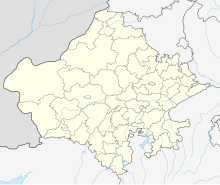Battle of Haldighati
From Wikipedia, the free encyclopedia
| Battle of Haldighati | |||||||
|---|---|---|---|---|---|---|---|
|
|||||||
| Empires | |||||||
| Mewar | Mughal | ||||||
| Commanders and leaders | |||||||
| Maharana Pratap (WIA) Hakim Khan Sur Rao Poonja Dodiya Bhim Man Singh Jhala Man Singh Bida Ramshah Tanwar Shalivahan Singh Tomar Krishnadas Chundawat Rao Chandra Sen |
Man Singh I Syed Hasim Syed Ahmed Khan Bahlol Khan Multan Khan Gazi Khan Badakshi Bhokal Singh Khorasan Wasim Khan |
||||||
| Strength | |||||||
| 22,000 (James Todd) 3,000 (Modern Estimates) |
80,000 (James Todd) 5,000 (Modern Estimates) |
||||||
Location within Rajasthan
|
Army strength
Maharana Pratap
In Maharana Pratap's army the main commanders were Gwalior's Ram Singh Tanvar (with all his sons), Krishandas Churawat, Ramdas Rathore Jhala, Mansingh Rawat, Purohit Gopinath, Shankardas, Charan Jaisa, Purohit Jagannath and Keshav. His army also included Afghans led by Hakim Khan Sur and a small contingent of 400-500 Bhil tribals headed by Rao Poonja fighting alongside him. He was also accompanied by Rao Chandra Sen of Marwar and his teacher Acharya Raghvendra. According to contemporary Mughal historians, Maharana's army had 3000 soldiers. According to Dr. Sharma, Maharana had 3,000 horseborne soldiers, 2,000 infantry soldiers, 100 elephants and 100 spearmen and some other soldiers. Besides these, there was an army of 400-500 Bheel soldiers also, along with Afghans.Akbar
According to contemporary historians the Mughal army had 40 000 soldiers. Their commander-in-chief was Man Singh I.Army formation
Pratap
Pratap's army was divided into a Harawal (front portion) led by Hakim Khan Sur, Chadrawal (back portion) led by Rao Poonja (Bheel General), left adjacent led by Jhala Mansingh, and south (right) adjacent led by Ramshah Tanwar (Ruler of Gwalior). Pratap himself was in the centre of the formation along with his minister Bhamashah and brother Tarachandra. An infantry of Bheels were stationed in the surrounding mountains.Formation
Mihtar Khan
Madhosingh
|______|Chandrawal|_______|
King Lurkaran |
Gazi Khan Man Singh I Ahmed Khan
Mughal Army
|
Maharana's Army
|____________|____________|
| Harawal |
| Hakim Khan Sur |
| Churawat Krishnadas |
| Bhimsingh |
| Rawat Sangha |
| Ramdas |
Left Adjacent Right Adjacent
Jhala Mansingh Pratap Ramshah
Jhala Beeda Bhamashah Shalivahan
Songara Tarachandra Bhagwan
| Pratap Singh
|_______|Chandrawal|______|
Punja
Purohit Gopinath
Jagannath
Mahatta Ratanchandra
Mahasani Jagannath
Jesa
Battle
In 1576, Akbar deputed Man Singh I and Asaf Khan I to lead a force against Maharana Pratap. The Rana advanced with a force numbering almost half the Mughal numbers and took a position near Haldighati which was at the entrance of a defile. In Pratap's army the main commanders were Gwalior's Ram Shah Tanwar and his three sons,Rawat Krishnadasji Chundawat, Maan Singhji Jhala and Chandrasenji Rathore of Marwar. His army also included Afghans led by Hakim Khan Sur and a small contingent of Bhil tribals headed by Rao Poonjaji fighting alongside him. Anticipating the mughal attack, the Rana had also devastated the entire region up to Chittor to prevent the Mughal forces access to food and fodder. The Mughals were then guided by Pratap's brother Shakti Singh that what was the way they could face Pratap in open and with minimum casualties.The Battle of Haldighati was fought on 18 June 1576 for around 4 hours. It was primarily fought in the traditional manner between cavalry and elephants since the Mughals found it difficult to transport artillery over the rough terrain. In a traditional fight, the Rajputs were at an advantage; their impetuous attack led to a crumbling of the Mughal left and right wings and put pressure on the center until reserves, but a rumor of Akbar's arrival turned the tide, and resulted in a Rajput retreat. The heat, and fear of ambush in the hills, resulted in the Mughals deciding not to pursue the Rajputs into the hills. Thus this battle failed to break the existing stalemate. After the battle Akbar captured many Rajput forts including the Mewarian capital Udaipur This fight can be viewed as an assertion of local independence arising from local and regional patriotism.

No comments:
Post a Comment